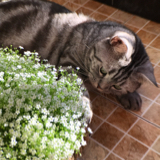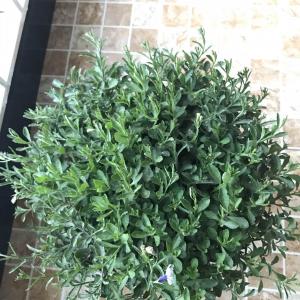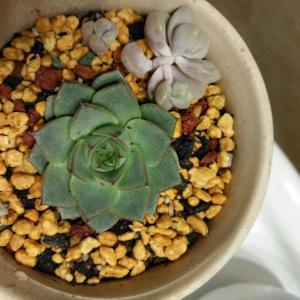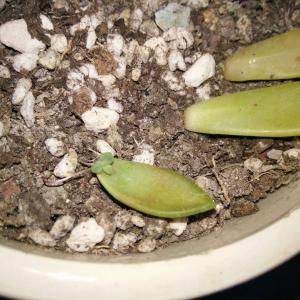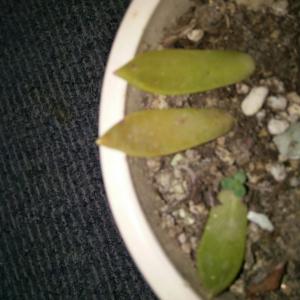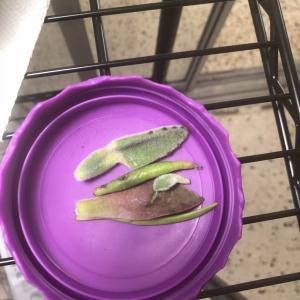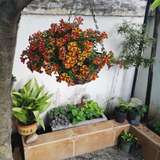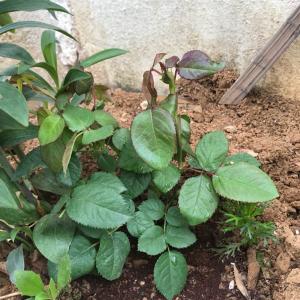文章
Miss Chen
2018年05月04日

Description: This annual plant consists of sprawling stems with pairs of opposite leaves. The stems are up to 5 cm. (2") long; they are whitish green and occasionally branch. The opposite leaves are 3-4 mm. long and about half as much across; they are medium green, ovate-oblong or obovate-oblong, and smooth along their margins. Each leaf tapers to a short petiole. There are separate male and female flowers on each plant (monoecious) at the axils of the leaves. These flowers are very small (less than 1/8" across) and greenish. Each male flower produces a single stamen, while each female flowers produces a single pistil with a pair of styles. These flowers have neither petals nor sepals. The blooming period occurs from late spring to mid-summer and lasts 1-2 months. The fruit of each female flower is 4-celled; it has a double-ovoid shape (similar to the fruit of a Galium sp.) and a short peduncle. Each cell of the fruit contains a single nutlet. This plant reproduces primarily by reseeding itself; it can reproduce vegetatively by forming rootlets at the axils of the leaves.
Cultivation: The preference is light shade to dappled sunlight, moist to dry-mesic conditions, and barren soil that is devoid of competing ground vegetation. This plant is often found on compacted soil containing clay, glacial till, or rocky material.
Range & Habitat: The native Terrestrial Starwort occurs occasionally in the southern half of Illinois; it is largely absent in the northern half of the state (see Distribution Map). Habitats include barren areas of hilly upland woodlands (particularly those that are dominated by oaks), edges of bluffs, footpaths in wooded areas, shaded gravelly seeps, and rocky riverbanks.
Faunal Associations: Information about floral-faunal relationships for this species is unavailable.

Photographic Location: Along a bluff in Vermilion County, Illinois.
Comments: This is probably the smallest terrestrial flowering plant in Illinois (Lemma minor, or Lesser Pondweed, is even smaller, but it floats on water). To see the flowers and fruits near the axils of the leaves, a 10x hand lens is required. Terrestrial Starwort resembles a low-growing moss, but it is more leafy in appearance. Other species in this genus are submerged or emergent aquatic plants; these Callitriche spp. are referred to as Water Starworts, and they are small in size as well. The submerged leaves of these latter species are linear in shape, but their emergent leaves resemble those of Terrestrial Starwort. While the fruits of Terrestrial Starwort have short peduncles, the fruits of Water Starworts are sessile, or nearly so.
Cultivation: The preference is light shade to dappled sunlight, moist to dry-mesic conditions, and barren soil that is devoid of competing ground vegetation. This plant is often found on compacted soil containing clay, glacial till, or rocky material.
Range & Habitat: The native Terrestrial Starwort occurs occasionally in the southern half of Illinois; it is largely absent in the northern half of the state (see Distribution Map). Habitats include barren areas of hilly upland woodlands (particularly those that are dominated by oaks), edges of bluffs, footpaths in wooded areas, shaded gravelly seeps, and rocky riverbanks.
Faunal Associations: Information about floral-faunal relationships for this species is unavailable.

Photographic Location: Along a bluff in Vermilion County, Illinois.
Comments: This is probably the smallest terrestrial flowering plant in Illinois (Lemma minor, or Lesser Pondweed, is even smaller, but it floats on water). To see the flowers and fruits near the axils of the leaves, a 10x hand lens is required. Terrestrial Starwort resembles a low-growing moss, but it is more leafy in appearance. Other species in this genus are submerged or emergent aquatic plants; these Callitriche spp. are referred to as Water Starworts, and they are small in size as well. The submerged leaves of these latter species are linear in shape, but their emergent leaves resemble those of Terrestrial Starwort. While the fruits of Terrestrial Starwort have short peduncles, the fruits of Water Starworts are sessile, or nearly so.
0
0
文章
秋田
2018年05月04日

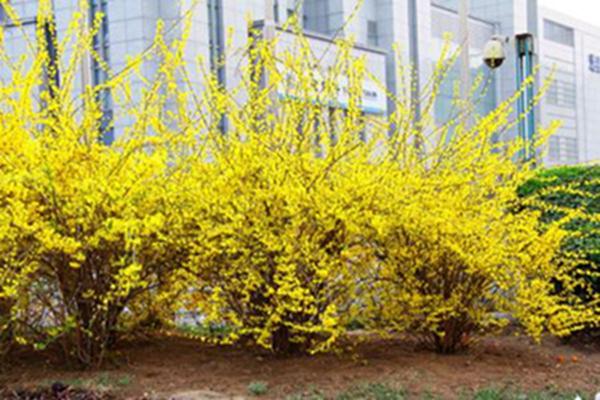
一、制作办法
1、大概种了3年左右,它的主干就会很粗。可以让它作弯,或者把它的顶部去掉,或者摘心,这就是初期的造型。要注意给它培养过渡的枝,让盆景长大后的枝和干的粗细更加协调。然后还可以到山野挖一些老桩给做成盆景,形态会十分的雅致,在很短的时间内就可以成型。
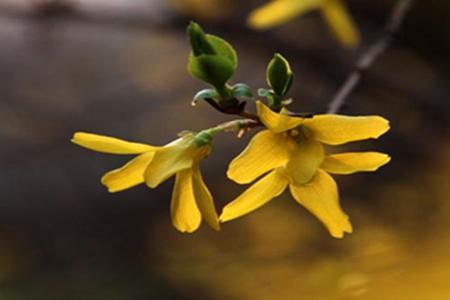
2、春天它看上去非常的灿烂,夏秋绿叶非常有生机。一般常见的盆栽形式有直干的形式,或者斜状的,或者弯曲的,或者放在水旁的,或者放在石头上的,都非常的好看。如果是人工的方式繁衍的植株,可以在它是幼苗的时候就对它的主干进行蟠扎和裁剪。因为它的枝比较长,在它的成长期就需要控制枝成长,促进侧芽新生,长成紧实的树冠,等到六月,它的新生的枝有六七成木质化,就可以蟠扎了,以此调整树冠。
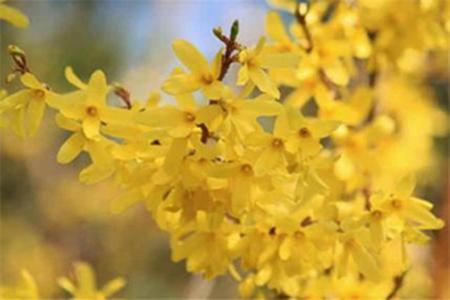
二、养护办法
1、首先在冬天到春天的时候把它给移种,先对它进行整形,把不需要的枝条给剪掉,然后把它种在比较大的花盆中,最好用比较疏松足够透气,排水效果比较好的沙土。然后把土给压实,给它浇透水,放在避风但是朝阳的地方。在它活下来之后等它的土干了再浇水,如果要浇,就要浇透。盆中的土太湿或者太干,都对它的成长不好,在成长期注意给它除芽,剪掉多的枝条。
2、它喜欢温暖有光的区域,可以忍受寒冷和干旱,但是害怕积水。在成长期间的时候可以把它放在屋外阳光比较足够,空气比较流通的地方,即使是高温也不用给它遮光,土不能太过于干旱,平常也要注意排水。要把多余的枝给去掉,保持它形态的优美,姿态的简约。

1
1
文章
Miss Chen
2018年05月03日

Description: This perennial plant is about 2-3' tall, branching occasionally. This member of the Nettle family lacks stinging hairs. The stems are light green, 4-angled or round, and glabrous or slightly pubescent. The leaves are usually opposite along the stems, but sometimes they are alternate. They are ovate or ovate-lanceolate, up to 4" long and 2½" across, and have long slender petioles. The upper surface of each leaf is dark green (in the shade) and glabrous or slightly pubescent; a central vein and 2 parallel secondary veins are readily observable. The margins are coarsely serrated. Spikes of green or greenish white flowers appear from the axils of the upper leaves. They are straight and angle upward from the axis of the central stem. The flowering spikes are about ½–3" long; sometimes they are terminal, but more often they will develop additional leaves beyond the flowers. False Nettle is usually dioecious, with male and female flowers produced on separate plants. Male flowers are distributed along the spikes in bunches, while female flowers are produced along the spikes more or less continuously. These flowers are very small and lack petals. Each male flower has a 4-parted calyx and 4 stamens, while the calyx of the female flower is tubular with 2-4 teeth. The blooming period is mid-summer to early fall, and lasts about 1-2 months. There is no floral scent; pollination is by wind. The fruit consists of a small achene. This description applies to the typical woodland variety of False Nettle, Boehmeria cylindrica cylindrica. The other variety of False Nettle, Boehmeria cylindrica drummondiana, grows in the sun and has a somewhat different appearance.

Cultivation: The preference is light shade, moist conditions, and rich loamy soil. In sunnier locations, this plant prefers wetter ground and the foliage may become yellowish green.
Range & Habitat: The native False Nettle is a common plant that occurs in most counties of Illinois (see Distribution Map). Habitats include wet to mesic deciduous woodlands, especially in floodplain and bottomland areas, as well as various wetlands, including swamps, low areas along rivers, borders of small streams, seeps, and sandy marshes. False Nettle can be found in both degraded and higher quality habitats.
Faunal Associations: The flowers don't attact many insects because they are wind-pollinated. Caterpillars of the butterflies Polygonia comma (Comma), Polygonia interrogationis (Question Mark), and Vanessa atalanta (Red Admiral) feed on the foliage of False Nettle; caterpillars of the moth Bomolocha manalis (Flowing-Line Bomolocha) also feed on this plant (Wagner, 2005; Bouseman & Sternburg, 2001). Larvae of a fly, Neolasioptera boehmeriae, form spindle-shaped galls on the stems. Because the foliage lacks stinging hairs and it is non-toxic, mammalian herbivores probably browse on this plant occasionally.
Photographic Location: Along a woodland path at Busey Woods in Urbana, Illinois.
Comments: Sometimes people instinctively shy away from this plant thinking that it has stinging hairs – in fact, this is not the case, hence the common name. In Illinois, the two members of the Nettle family with stinging hairs are Laportea canadensis (Wood Nettle) and Urtica dioica (Stinging Nettle). The latter species has been introduced from Europe. The other common member of the Nettle family without stinging hairs, Pilea pumila (Clearweed), is a hairless annual plant with translucent stems and shiny leaves. Clearweed has terminal flowering spikes that are usually shorter than the petioles of the leaves, while the flowering spikes of False Nettle are usually longer than the petioles, and leaves are often produced beyond the flowers.

Cultivation: The preference is light shade, moist conditions, and rich loamy soil. In sunnier locations, this plant prefers wetter ground and the foliage may become yellowish green.
Range & Habitat: The native False Nettle is a common plant that occurs in most counties of Illinois (see Distribution Map). Habitats include wet to mesic deciduous woodlands, especially in floodplain and bottomland areas, as well as various wetlands, including swamps, low areas along rivers, borders of small streams, seeps, and sandy marshes. False Nettle can be found in both degraded and higher quality habitats.
Faunal Associations: The flowers don't attact many insects because they are wind-pollinated. Caterpillars of the butterflies Polygonia comma (Comma), Polygonia interrogationis (Question Mark), and Vanessa atalanta (Red Admiral) feed on the foliage of False Nettle; caterpillars of the moth Bomolocha manalis (Flowing-Line Bomolocha) also feed on this plant (Wagner, 2005; Bouseman & Sternburg, 2001). Larvae of a fly, Neolasioptera boehmeriae, form spindle-shaped galls on the stems. Because the foliage lacks stinging hairs and it is non-toxic, mammalian herbivores probably browse on this plant occasionally.
Photographic Location: Along a woodland path at Busey Woods in Urbana, Illinois.
Comments: Sometimes people instinctively shy away from this plant thinking that it has stinging hairs – in fact, this is not the case, hence the common name. In Illinois, the two members of the Nettle family with stinging hairs are Laportea canadensis (Wood Nettle) and Urtica dioica (Stinging Nettle). The latter species has been introduced from Europe. The other common member of the Nettle family without stinging hairs, Pilea pumila (Clearweed), is a hairless annual plant with translucent stems and shiny leaves. Clearweed has terminal flowering spikes that are usually shorter than the petioles of the leaves, while the flowering spikes of False Nettle are usually longer than the petioles, and leaves are often produced beyond the flowers.
0
0
文章
Miss Chen
2018年05月03日

Description: During the first year, this biennial plant consists of a rosette of basal leaves spanning about 6" across. These basal leaves are up to 3½" long and ¾" across; they are obovate or oblanceolate, shallowly lobed or dentate along the margins, and nearly hairless. During the second year, a flowering stalk develops up to 3' tall that is unbranched or sparingly branched; it often leans over to one side. This stalk is pale green, hairless, and glaucous. The cauline (alternate) leaves are up to 8" long and 1" across, becoming smaller as they ascend the central stalk. They are usually lanceolate, hairless, and glaucous; some of the upper leaves are linear. The margins of these leaves are smooth or sparingly dentate. The base of each cauline leaf clasps the central stalk with a pair of basal lobes. Normally, the cauline leaves are some shade of green, but they can become reddish or yellowish green in bright sunlight.
The central stalk (and any secondary stalks) terminates in an elongated raceme of flowers up to 1½' long. The small flowers bloom near the apex of this raceme, while the siliques (slender cylindrical seedpods) droop from their pedicels below. Each flower is about 4 mm. (1/6") across, consisting of 4 white petals, 4 light green sepals, a pistil with an undivided style, and several stamens. The petals are barely longer than the sepals. The pedicel of each flower is about 8 mm. (1/3") long, hairless, and ascending. The blooming period occurs from mid-spring to early summer and lasts about 1-2 months. Each flower is replaced by a slender silique up to 3½" long that is hairless; it contains a single row of small seeds with winged margins. The siliques spread widely or droop from their pedicels. When the siliques split open to release their seeds, the latter can be carried aloft to some extent by the wind. The root system consists of a taproot. This plant spreads by reseeding itself.

Cultivation: The preference is medium shade to partial sunlight, moist to slightly dry conditions, and a soil that is loamy or rocky. The size of a plant and the appearance of its foliage can be strongly influenced by its growing conditions.
Range & Habitat: Smooth Rock Cress occurs occasionally in most areas of Illinois (see Distribution Map), where it is native. In some areas, it may be locally common. Habitats include mesic woodlands, thinly wooded bluffs, rocky slopes of bluffs, shaded cliffs, and ravines near streams. This plant is generally found in hilly woodlands where deciduous trees are dominant.

Faunal Associations: Small bees and flies occasionally visit the flowers for nectar or pollen. Bee visitors include Ceratina spp. (little carpenter bees), Nomada spp. (cuckoo bees), Osmia spp. (mason bees), Halictid bees, and Andrenid bees, including Andrena arabis (Rock Cress Andrenid Bee). Some insects feed on the foliage and other parts of Boechera spp. and related genera (Rock Cress species); they include larvae of the leaf-mining fly Liriomya pusilla, the flea beetles Phyllotreta conjuncta and Phyllotreta punctulata, and caterpillars of the butterflies Anthocharis midea (Falcate Orangetip) and Pieris oleracea (Mustard White). The foliage of these plants doesn't appear to be bothered by either deer or rabbits to any significant degree (personal observation).
Photographic Location: The photographs were taken at a wooded ravine near a stream in Vermilion County, Illinois, and at a mesic deciduous woodland in Douglas County, Illinois.

Comments: This is one of the native species of Rock Cress (Boechera spp. and related genera) that can be found in wooded areas. This plant is not particularly showy and it is often overlooked. Smooth Rock Cress (Boechera laevigata) can be distinguished from other species of Rock Cress as follows: 1) It is completely hairless during the blooming period, 2) it has siliques that are widely spreading or drooping, and 3) its cauline leaves clasp their stems with a pair of basal lobes. These three characteristics are usually sufficient to distinguish this species from other species of Rock Cress. Some other characteristics that are occasionally helpful: 1) Its siliques are circular in cross-section, rather than flattened, and 2) each of its siliques contains a single row of seeds. For example, another woodland species, Boechera canadensis (Sicklepod), has an appearance that is similar to Smooth Rock Cress; they both have drooping siliques. However, the cauline leaves of Sicklepod are sessile, its lower foliage is often hairy, and it has flattened siliques. A scientific synonym of Smooth Rock Cress is Arabis laevigata.
The central stalk (and any secondary stalks) terminates in an elongated raceme of flowers up to 1½' long. The small flowers bloom near the apex of this raceme, while the siliques (slender cylindrical seedpods) droop from their pedicels below. Each flower is about 4 mm. (1/6") across, consisting of 4 white petals, 4 light green sepals, a pistil with an undivided style, and several stamens. The petals are barely longer than the sepals. The pedicel of each flower is about 8 mm. (1/3") long, hairless, and ascending. The blooming period occurs from mid-spring to early summer and lasts about 1-2 months. Each flower is replaced by a slender silique up to 3½" long that is hairless; it contains a single row of small seeds with winged margins. The siliques spread widely or droop from their pedicels. When the siliques split open to release their seeds, the latter can be carried aloft to some extent by the wind. The root system consists of a taproot. This plant spreads by reseeding itself.

Cultivation: The preference is medium shade to partial sunlight, moist to slightly dry conditions, and a soil that is loamy or rocky. The size of a plant and the appearance of its foliage can be strongly influenced by its growing conditions.
Range & Habitat: Smooth Rock Cress occurs occasionally in most areas of Illinois (see Distribution Map), where it is native. In some areas, it may be locally common. Habitats include mesic woodlands, thinly wooded bluffs, rocky slopes of bluffs, shaded cliffs, and ravines near streams. This plant is generally found in hilly woodlands where deciduous trees are dominant.

Faunal Associations: Small bees and flies occasionally visit the flowers for nectar or pollen. Bee visitors include Ceratina spp. (little carpenter bees), Nomada spp. (cuckoo bees), Osmia spp. (mason bees), Halictid bees, and Andrenid bees, including Andrena arabis (Rock Cress Andrenid Bee). Some insects feed on the foliage and other parts of Boechera spp. and related genera (Rock Cress species); they include larvae of the leaf-mining fly Liriomya pusilla, the flea beetles Phyllotreta conjuncta and Phyllotreta punctulata, and caterpillars of the butterflies Anthocharis midea (Falcate Orangetip) and Pieris oleracea (Mustard White). The foliage of these plants doesn't appear to be bothered by either deer or rabbits to any significant degree (personal observation).
Photographic Location: The photographs were taken at a wooded ravine near a stream in Vermilion County, Illinois, and at a mesic deciduous woodland in Douglas County, Illinois.

Comments: This is one of the native species of Rock Cress (Boechera spp. and related genera) that can be found in wooded areas. This plant is not particularly showy and it is often overlooked. Smooth Rock Cress (Boechera laevigata) can be distinguished from other species of Rock Cress as follows: 1) It is completely hairless during the blooming period, 2) it has siliques that are widely spreading or drooping, and 3) its cauline leaves clasp their stems with a pair of basal lobes. These three characteristics are usually sufficient to distinguish this species from other species of Rock Cress. Some other characteristics that are occasionally helpful: 1) Its siliques are circular in cross-section, rather than flattened, and 2) each of its siliques contains a single row of seeds. For example, another woodland species, Boechera canadensis (Sicklepod), has an appearance that is similar to Smooth Rock Cress; they both have drooping siliques. However, the cauline leaves of Sicklepod are sessile, its lower foliage is often hairy, and it has flattened siliques. A scientific synonym of Smooth Rock Cress is Arabis laevigata.
0
0
文章
Miss Chen
2018年05月03日

Description: This perennial plant is 1-3' tall and unbranched or sparingly branched. The central stem is light to dark green, 4-angled, and covered with long white hairs. The opposite leaves are up to 3½" long and 1½" across. They are ovate or lanceolate-ovate in shape, serrated along their margins, and often ciliate. The lower surface of each leaf is light to medium green and densely pubescent to nearly glabrous; in the latter case, there are scattered hairs along the central and some of the lateral veins. The upper leaf surface is medium to dark green; it has either scattered appressed hairs or it is glabrous. The petioles are about ½-1¼" long and covered with spreading hairs. Small secondary leaves often develop from the axils of the leaves on the central stem.
The central stem (and any major side stems) terminates in several whorls of flowers. The whorls of flowers occur above the axils of the upper leaves, or they may occur above pairs of leafy bracts that are sometimes inconspicuous. The flowers in each whorl are densely crowded together. Each flower is up to ½" long, consisting of a short-tubular calyx with 5 teeth, a 2-lipped corolla, 2 exerted stamens, and a slender style that is divided at its tip. The calyx is light green and exceedingly hairy along the margins of its teeth; the upper teeth are longer than the lower teeth. The corolla is light purple or white and it has purple dots on the lower lip; the outer surface of this corolla is finely pubescent on the upper side. The lower lip is divided into 3 lobes, while the upper lip functions as a protective hood. The blooming period occurs during the summer and lasts about 1-1½ months. Each flower is replaced by 4 ovoid nutlets. The root system is fibrous and rhizomatous. Clonal colonies of plants often develop from the rhizomes.

Cultivation: The preference is partial sun to light shade, moist to mesic conditions, and a rich loamy soil with decaying leaf mold. This species also grows in soil that is somewhat rocky.
Range & Habitat: The native Hairy Wood Mint occurs occasionally throughout Illinois (see Distribution Map). Habitats include mesic deciduous woodlands, areas along woodland paths, woodland borders, woodland openings, limestone glades, and thickets. Minor disturbance is desirable if it removes excessive shade from the overhead canopy.

Faunal Associations: The flowers are pollinated primarily by long-tongued bees, including honeybees, bumblebees, little carpenter bees (Ceratina spp.), mason bees (Osmia spp.), leaf-cutting bees (Megachile spp.), cuckoo bees (Epeolus spp.), long-horned bees (Melissodes spp.), and Anthophorid bees (Anthophora spp.). Other visitors of the flowers include Halictid bees, wasps, bee flies (Bombyliidae), thick-headed flies (Conopidae), Syrphid flies, butterflies, and skippers. These insects seek nectar primarily, although some of the Halictid bees collect pollen and some flies feed on the pollen. There are few records of insects feeding destructively on Hairy Wood Mint, although a polyphagous aphid, Aphis coreopsidis, uses this plant as a summer host. The foliage probably isn't attractive to mammalian herbivores as a food source.

Photographic Location: Along a woodland path at Busey Woods in Urbana, Illinois.
Comments: This is another member of the Mint family with pairs of opposite leaves and relatively small tubular flowers. Hairy Wood Mint (Blephilia hirsuta) has unusually hairy stems and the dense hairy whorls of flowers are rather conspicuous. These dense whorls of flowers distinguish the genus Blephilia from many other members of the Mint family. The only other member of this genus that occurs in Illinois is Downy Wood Mint (Blephilia ciliata). Downy Wood Mint has leaves that are sessile or they have short petioles (less than ½"), and its stems are short-pubescent to pubescent. Hairy Wood Mint, on the other hand, has leaves with longer petioles and its stems have spreading white hairs that are quite long. Downy Wood Mint prefers habitats that are somewhat sunnier and drier; it is sometimes found in prairies and savannas.
The central stem (and any major side stems) terminates in several whorls of flowers. The whorls of flowers occur above the axils of the upper leaves, or they may occur above pairs of leafy bracts that are sometimes inconspicuous. The flowers in each whorl are densely crowded together. Each flower is up to ½" long, consisting of a short-tubular calyx with 5 teeth, a 2-lipped corolla, 2 exerted stamens, and a slender style that is divided at its tip. The calyx is light green and exceedingly hairy along the margins of its teeth; the upper teeth are longer than the lower teeth. The corolla is light purple or white and it has purple dots on the lower lip; the outer surface of this corolla is finely pubescent on the upper side. The lower lip is divided into 3 lobes, while the upper lip functions as a protective hood. The blooming period occurs during the summer and lasts about 1-1½ months. Each flower is replaced by 4 ovoid nutlets. The root system is fibrous and rhizomatous. Clonal colonies of plants often develop from the rhizomes.

Cultivation: The preference is partial sun to light shade, moist to mesic conditions, and a rich loamy soil with decaying leaf mold. This species also grows in soil that is somewhat rocky.
Range & Habitat: The native Hairy Wood Mint occurs occasionally throughout Illinois (see Distribution Map). Habitats include mesic deciduous woodlands, areas along woodland paths, woodland borders, woodland openings, limestone glades, and thickets. Minor disturbance is desirable if it removes excessive shade from the overhead canopy.

Faunal Associations: The flowers are pollinated primarily by long-tongued bees, including honeybees, bumblebees, little carpenter bees (Ceratina spp.), mason bees (Osmia spp.), leaf-cutting bees (Megachile spp.), cuckoo bees (Epeolus spp.), long-horned bees (Melissodes spp.), and Anthophorid bees (Anthophora spp.). Other visitors of the flowers include Halictid bees, wasps, bee flies (Bombyliidae), thick-headed flies (Conopidae), Syrphid flies, butterflies, and skippers. These insects seek nectar primarily, although some of the Halictid bees collect pollen and some flies feed on the pollen. There are few records of insects feeding destructively on Hairy Wood Mint, although a polyphagous aphid, Aphis coreopsidis, uses this plant as a summer host. The foliage probably isn't attractive to mammalian herbivores as a food source.

Photographic Location: Along a woodland path at Busey Woods in Urbana, Illinois.
Comments: This is another member of the Mint family with pairs of opposite leaves and relatively small tubular flowers. Hairy Wood Mint (Blephilia hirsuta) has unusually hairy stems and the dense hairy whorls of flowers are rather conspicuous. These dense whorls of flowers distinguish the genus Blephilia from many other members of the Mint family. The only other member of this genus that occurs in Illinois is Downy Wood Mint (Blephilia ciliata). Downy Wood Mint has leaves that are sessile or they have short petioles (less than ½"), and its stems are short-pubescent to pubescent. Hairy Wood Mint, on the other hand, has leaves with longer petioles and its stems have spreading white hairs that are quite long. Downy Wood Mint prefers habitats that are somewhat sunnier and drier; it is sometimes found in prairies and savannas.
0
0
文章
Miss Chen
2018年05月03日

Description: This perennial wildflower is 2-6' tall and usually unbranched. The central stem is light green to purplish green, terete, and glabrous. Opposite pairs of leaves about 3-8" long and 1-3" across occur along this stem; they are lanceolate-elliptic to ovate and smooth along their margins. Both the tips and bottoms of the leaves are wedge-shaped, rather than rounded. The upper leaf surface is medium to dark green and glabrous, while the lower surface is pale to medium green and glabrous (or nearly so). The leaves are widely spreading and remain more or less the same size along the stem. The distinct petioles are ½-2" long and light green. The foliage contains a milky latex.
The stem terminates in one or more umbels of flowers spanning 2-4" across. The umbels are relatively open and the flowers droop somewhat from their pedicels. Each flower is about ¼" across and ½" long, consisting of 5 petals that hang downward, 5 curved cylindrical hoods that surround a central column, and the reproductive organs. The insignificant sepals are hidden by the petals. Each hood has an exerted horn. The flowers are bicolored: the petals are green or pale purple, while the hoods and column are white or light pink. The slender pedicels are 1-2" long, light green, and either glabrous or minutely short-pubescent. The blooming period occurs during the summer for about a month. Afterwards, fertile flowers are replaced by erect seedpods (follicles) that are up to 6" long and ¾" across; they are narrowly lanceoloid in shape. During the fall, each seedpod splits open along one side to release its seeds. The seeds have tufts of hair at their apices; they are distributed by the wind. The root system consists of a taproot.

Cultivation: The preference is partial or dappled sunlight, mesic conditions, and a rich loam or sandy loam with organic matter. The location should be protected from prevailing winds.
Range & Habitat: Poke Milkweed is widely distributed across Illinois, but it is relatively uncommon. Illinois lies along the western range limit of this species. Habitats consist of woodland openings, rich mesic woodlands, sandy woodlands, upland rocky woodlands, wooded slopes, areas along paths in woodlands, and woodland borders. Poke Milkweed is found in deciduous woodlands where oaks, maples, and similar trees are dominant.
Faunal Associations: The flowers of Poke Milkweed attract bumblebees and butterflies, including the Monarch and Great Spangle Fritillary butterflies. These insects suck nectar from the flowers. Other insects feed on the foliage, flower tissues, seedpods, pith of the stems, or plant juices. The following beetles have been found on Poke Milkweed: Chrysochus auratus (Dogbane Beetle) and Labidomera clivicollis (Swamp Milkweed Leaf Beetle). Other insects that feed on milkweeds (Asclepias spp.) include larvae of Tetraopes basalis (Milkweed Longhorn) and Tetraopes tetrophthalmus (Red Milkweed Beetle), larvae of Rhyssomatus lineaticollis (Milkweed Stem Weevil), Lygaeus kalmii (Small Milkweed Bug) and Oncopeltus fasciatus (Large Milkweed Bug), Aphis asclepiadis and other aphids, caterpillars of the moths Cycnia inopinatus (Unexpected Cycnia) and Cycnia tenera (Delicate Cycnia), and caterpillars of the butterfly Danaus plexippus (Monarch). Mammalian herbivores usually avoid consumption of milkweeds because their foliage contains toxic cardiac glycosides and it is bitter-tasting.
Photographic Location: Along a path in a sandy woodland at the Indiana Dunes State Park in NW Indiana.
Comments: This is a tall-growing milkweed with unusual bicolored flowers. In Illinois, only Swamp Milkweed (Asclepias incarnata) and Common Milkweed (Asclepias syriaca) are as tall and their flowers are usually more unicolored. In some areas of the United States, Poke Milkweed has been known to hybridize with Common Milkweed, producing plants with intermediate characteristics. So far, such hybrid plants have not been observed in Illinois. The common name, Poke Milkweed, refers to a junior synonym of this species, Asclepias phytolaccoides. This latter scientific name was no doubt inspired by the superficial resemblance of this milkweed's leaves to those of an unrelated species, Pokeweed (Phytolacca americana).
The stem terminates in one or more umbels of flowers spanning 2-4" across. The umbels are relatively open and the flowers droop somewhat from their pedicels. Each flower is about ¼" across and ½" long, consisting of 5 petals that hang downward, 5 curved cylindrical hoods that surround a central column, and the reproductive organs. The insignificant sepals are hidden by the petals. Each hood has an exerted horn. The flowers are bicolored: the petals are green or pale purple, while the hoods and column are white or light pink. The slender pedicels are 1-2" long, light green, and either glabrous or minutely short-pubescent. The blooming period occurs during the summer for about a month. Afterwards, fertile flowers are replaced by erect seedpods (follicles) that are up to 6" long and ¾" across; they are narrowly lanceoloid in shape. During the fall, each seedpod splits open along one side to release its seeds. The seeds have tufts of hair at their apices; they are distributed by the wind. The root system consists of a taproot.

Cultivation: The preference is partial or dappled sunlight, mesic conditions, and a rich loam or sandy loam with organic matter. The location should be protected from prevailing winds.
Range & Habitat: Poke Milkweed is widely distributed across Illinois, but it is relatively uncommon. Illinois lies along the western range limit of this species. Habitats consist of woodland openings, rich mesic woodlands, sandy woodlands, upland rocky woodlands, wooded slopes, areas along paths in woodlands, and woodland borders. Poke Milkweed is found in deciduous woodlands where oaks, maples, and similar trees are dominant.
Faunal Associations: The flowers of Poke Milkweed attract bumblebees and butterflies, including the Monarch and Great Spangle Fritillary butterflies. These insects suck nectar from the flowers. Other insects feed on the foliage, flower tissues, seedpods, pith of the stems, or plant juices. The following beetles have been found on Poke Milkweed: Chrysochus auratus (Dogbane Beetle) and Labidomera clivicollis (Swamp Milkweed Leaf Beetle). Other insects that feed on milkweeds (Asclepias spp.) include larvae of Tetraopes basalis (Milkweed Longhorn) and Tetraopes tetrophthalmus (Red Milkweed Beetle), larvae of Rhyssomatus lineaticollis (Milkweed Stem Weevil), Lygaeus kalmii (Small Milkweed Bug) and Oncopeltus fasciatus (Large Milkweed Bug), Aphis asclepiadis and other aphids, caterpillars of the moths Cycnia inopinatus (Unexpected Cycnia) and Cycnia tenera (Delicate Cycnia), and caterpillars of the butterfly Danaus plexippus (Monarch). Mammalian herbivores usually avoid consumption of milkweeds because their foliage contains toxic cardiac glycosides and it is bitter-tasting.
Photographic Location: Along a path in a sandy woodland at the Indiana Dunes State Park in NW Indiana.
Comments: This is a tall-growing milkweed with unusual bicolored flowers. In Illinois, only Swamp Milkweed (Asclepias incarnata) and Common Milkweed (Asclepias syriaca) are as tall and their flowers are usually more unicolored. In some areas of the United States, Poke Milkweed has been known to hybridize with Common Milkweed, producing plants with intermediate characteristics. So far, such hybrid plants have not been observed in Illinois. The common name, Poke Milkweed, refers to a junior synonym of this species, Asclepias phytolaccoides. This latter scientific name was no doubt inspired by the superficial resemblance of this milkweed's leaves to those of an unrelated species, Pokeweed (Phytolacca americana).
0
0
文章
Miss Chen
2018年05月02日

米兰为楝科常绿灌木至小乔木。 分枝多,叶为奇数羽状复叶,小叶3-5枚,倒卵形,深绿色。圆锥花序腋生,花细小而繁密,黄色,清香。四季开花。
米兰喜湿润肥沃、疏松的壤土或砂壤土,以略呈酸性为宜。盆土可用25%堆肥、50%腐叶土、25%河砂混合配制。盆底放适量腐熟饼肥作基肥。米兰喜温暖,气温在16℃时开始发新枝,25℃时,植株生长旺盛。

米兰花养殖三大技巧
米兰是多年生观叶观花常绿灌木花卉,四季青枝绿叶、分枝多、叶片密,株形秀丽、花色金黄、芳香宜人。养护盆栽米兰,要掌握以下技巧:
技巧1、施肥技巧一般应每月施一次肥,以有机肥和高效磷钾肥为主,切忌偏施氮肥。每次每盆施沤制腐熟并已除臭的花生饼肥或菜籽饼肥或茶籽饼肥25~30克,磷酸二氢钾或高效生物磷钾肥15~20克,兑清水或沤制腐熟并已除臭的人畜粪水2~3千克后淋施。
技巧2、浇水技巧全年都要保持盆土处于湿润状态,切勿干旱出现龟裂,但也不能长时间过湿,否则会沤根、烂根、黄叶。一般夏、秋季每天浇一次清水,冬、春季每2~3天浇一次清水,以水分能够迅速渗透入盆土中,不积在盆土上为宜。同时,要经常向枝叶上喷洒清水,特别是夏季高温和冬季干旱时期,均匀喷湿所有的枝叶,以开始有水珠往下滴为宜,以使枝叶保持湿润。
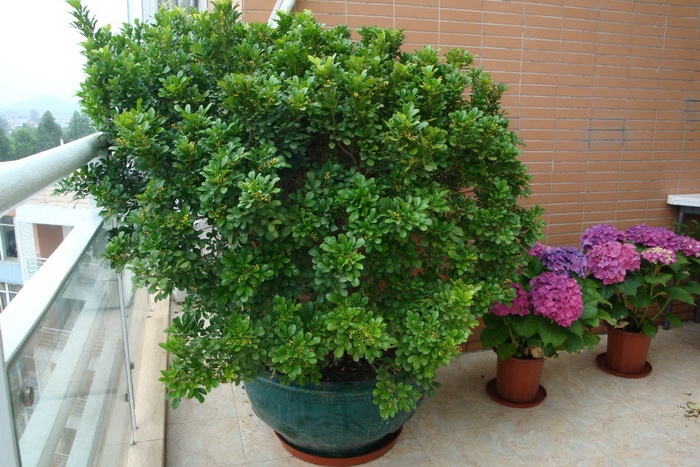
技巧3、喷药技巧盆栽米兰受白粉病、叶斑病、炭疽病、红蜘蛛、介壳虫、蚜虫、锈壁虱等病虫为害相当严重,使枝叶黄化枯死,可每15~20天叶面喷洒一次25~30倍干燥纯净的草木灰与过磷酸钙混合浸出的澄清液,或0.1%石灰水澄清液等进行无公害防治,以保护枝叶,防止各种病虫为害。越冬米兰的养护米兰是人们喜爱的一种花卉,但它的生性耐热怕寒。
米兰花开放时节香气袭人。作为食用花卉,可提取香精。如米兰花茶。盆栽可陈列于客厅、书房和门廊,清新幽雅,舒人心身。在南方庭院中米兰又是极好的风景树。放在居室中可吸收空气中的二氧化硫、和氯气,净化空气。若是喜欢的话就赶紧入手一盆吧!
米兰喜湿润肥沃、疏松的壤土或砂壤土,以略呈酸性为宜。盆土可用25%堆肥、50%腐叶土、25%河砂混合配制。盆底放适量腐熟饼肥作基肥。米兰喜温暖,气温在16℃时开始发新枝,25℃时,植株生长旺盛。

米兰花养殖三大技巧
米兰是多年生观叶观花常绿灌木花卉,四季青枝绿叶、分枝多、叶片密,株形秀丽、花色金黄、芳香宜人。养护盆栽米兰,要掌握以下技巧:
技巧1、施肥技巧一般应每月施一次肥,以有机肥和高效磷钾肥为主,切忌偏施氮肥。每次每盆施沤制腐熟并已除臭的花生饼肥或菜籽饼肥或茶籽饼肥25~30克,磷酸二氢钾或高效生物磷钾肥15~20克,兑清水或沤制腐熟并已除臭的人畜粪水2~3千克后淋施。
技巧2、浇水技巧全年都要保持盆土处于湿润状态,切勿干旱出现龟裂,但也不能长时间过湿,否则会沤根、烂根、黄叶。一般夏、秋季每天浇一次清水,冬、春季每2~3天浇一次清水,以水分能够迅速渗透入盆土中,不积在盆土上为宜。同时,要经常向枝叶上喷洒清水,特别是夏季高温和冬季干旱时期,均匀喷湿所有的枝叶,以开始有水珠往下滴为宜,以使枝叶保持湿润。

技巧3、喷药技巧盆栽米兰受白粉病、叶斑病、炭疽病、红蜘蛛、介壳虫、蚜虫、锈壁虱等病虫为害相当严重,使枝叶黄化枯死,可每15~20天叶面喷洒一次25~30倍干燥纯净的草木灰与过磷酸钙混合浸出的澄清液,或0.1%石灰水澄清液等进行无公害防治,以保护枝叶,防止各种病虫为害。越冬米兰的养护米兰是人们喜爱的一种花卉,但它的生性耐热怕寒。
米兰花开放时节香气袭人。作为食用花卉,可提取香精。如米兰花茶。盆栽可陈列于客厅、书房和门廊,清新幽雅,舒人心身。在南方庭院中米兰又是极好的风景树。放在居室中可吸收空气中的二氧化硫、和氯气,净化空气。若是喜欢的话就赶紧入手一盆吧!
2
5
文章
Miss Chen
2018年05月02日

Close-up of FlowerDescription: This herbaceous perennial plant is 4-12" tall, consisting of a short stem that branches at ground level into 2 basal leaves with long petioles. The basal leaves are up to 3" long and 4" across. They are cordate-orbicular, deeply indented at the base, and have smooth margins. Their upper surface is slightly hairy and shiny. From the axil of a pair of leaves, develops a single reddish brown flower on a short stalk. Both the flowering stalk and the petioles of the leaves are covered with white hairs that are long and twisted. The flower is about 1" across; it has 3 calyx lobes that are triangular in shape and curl backward. The thick tubular base of calyx is divided into 6 rounded chambers (3 primary chambers, which are each divided into 2 secondary chambers). These chambers contain the ovaries, which develop into rows of seeds. The tubular base of the calyx is light reddish brown and covered with long white hairs. There is a stout column of reproductive organs at the throat of the flower, which is reddish brown like the lobes. It is surrounded by the inner surface of the calyx, which is white. The blooming period occurs from mid- to late spring, and lasts about 3 weeks. After the flowers wither away, the seed capsule splits open to release the seeds. These seeds have a fleshy appendage. The root system consists of shallow rhizomes that are fleshy and branching. This plant often forms vegetative colonies.
Cultivation: The preference is light shade and moist to slightly dry conditions. The soil should be rich and loamy, although some rocky material underneath the soil surface is acceptable.
Range & Habitat: The native Wild Ginger is a common plant that can be found in most counties of Illinois (see Distribution Map). Habitats include moist to slightly dry deciduous woodlands (both floodplain and upland), and bluffs. It often found along ravines and slopes.
Faunal Associations: The reddish brown flowers probably attract flies or beetles as pollinating agents. The seeds attract ants because of their fleshy appendages; these insects help to disperse the seeds. The toxic foliage is not eaten by mammalian herbivores.

Photographic Location: The edge of a wooded bluff at Kickapoo State Park in Vermilion County, Illinois, where this plant is quite common. The foliage in the upper left corner of the photograph of the basal leaves is Dentaria laciniata (Cutleaf Toothwort).
Comments: This plant is called 'Wild Ginger' because the aromatic rhizomes have a ginger-like fragrance and flavor. Fresh or dried, they can be used as a substitute for the spice. Different varieties of Wild Ginger have been described by different authorities, which vary according to the length of the calyx lobes, and whether they are spreading or reflexed. The variety that is described here, Asarum canadense reflexum, is the most common variety of Wild Ginger in Illinois.
Cultivation: The preference is light shade and moist to slightly dry conditions. The soil should be rich and loamy, although some rocky material underneath the soil surface is acceptable.
Range & Habitat: The native Wild Ginger is a common plant that can be found in most counties of Illinois (see Distribution Map). Habitats include moist to slightly dry deciduous woodlands (both floodplain and upland), and bluffs. It often found along ravines and slopes.
Faunal Associations: The reddish brown flowers probably attract flies or beetles as pollinating agents. The seeds attract ants because of their fleshy appendages; these insects help to disperse the seeds. The toxic foliage is not eaten by mammalian herbivores.

Photographic Location: The edge of a wooded bluff at Kickapoo State Park in Vermilion County, Illinois, where this plant is quite common. The foliage in the upper left corner of the photograph of the basal leaves is Dentaria laciniata (Cutleaf Toothwort).
Comments: This plant is called 'Wild Ginger' because the aromatic rhizomes have a ginger-like fragrance and flavor. Fresh or dried, they can be used as a substitute for the spice. Different varieties of Wild Ginger have been described by different authorities, which vary according to the length of the calyx lobes, and whether they are spreading or reflexed. The variety that is described here, Asarum canadense reflexum, is the most common variety of Wild Ginger in Illinois.
0
0


